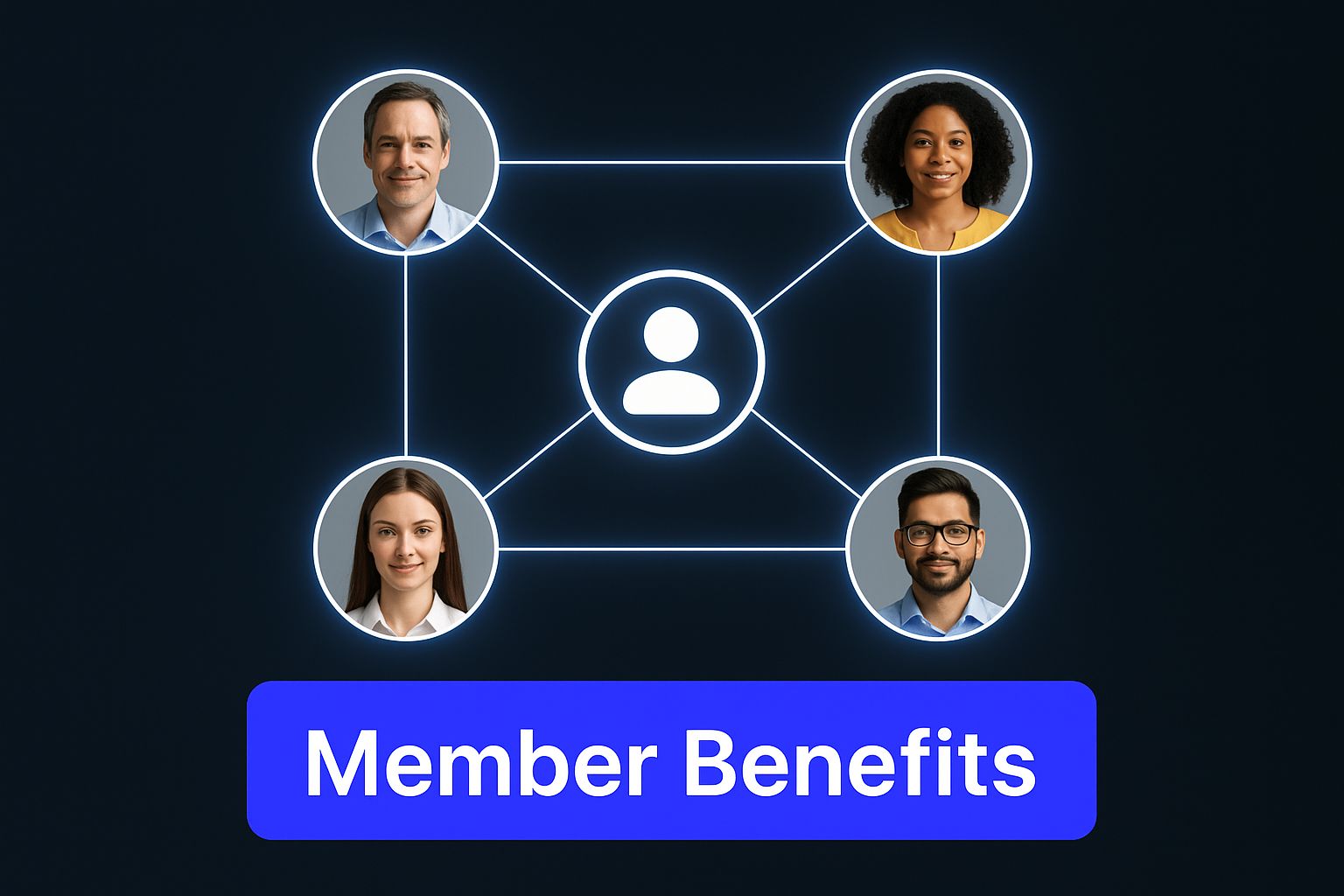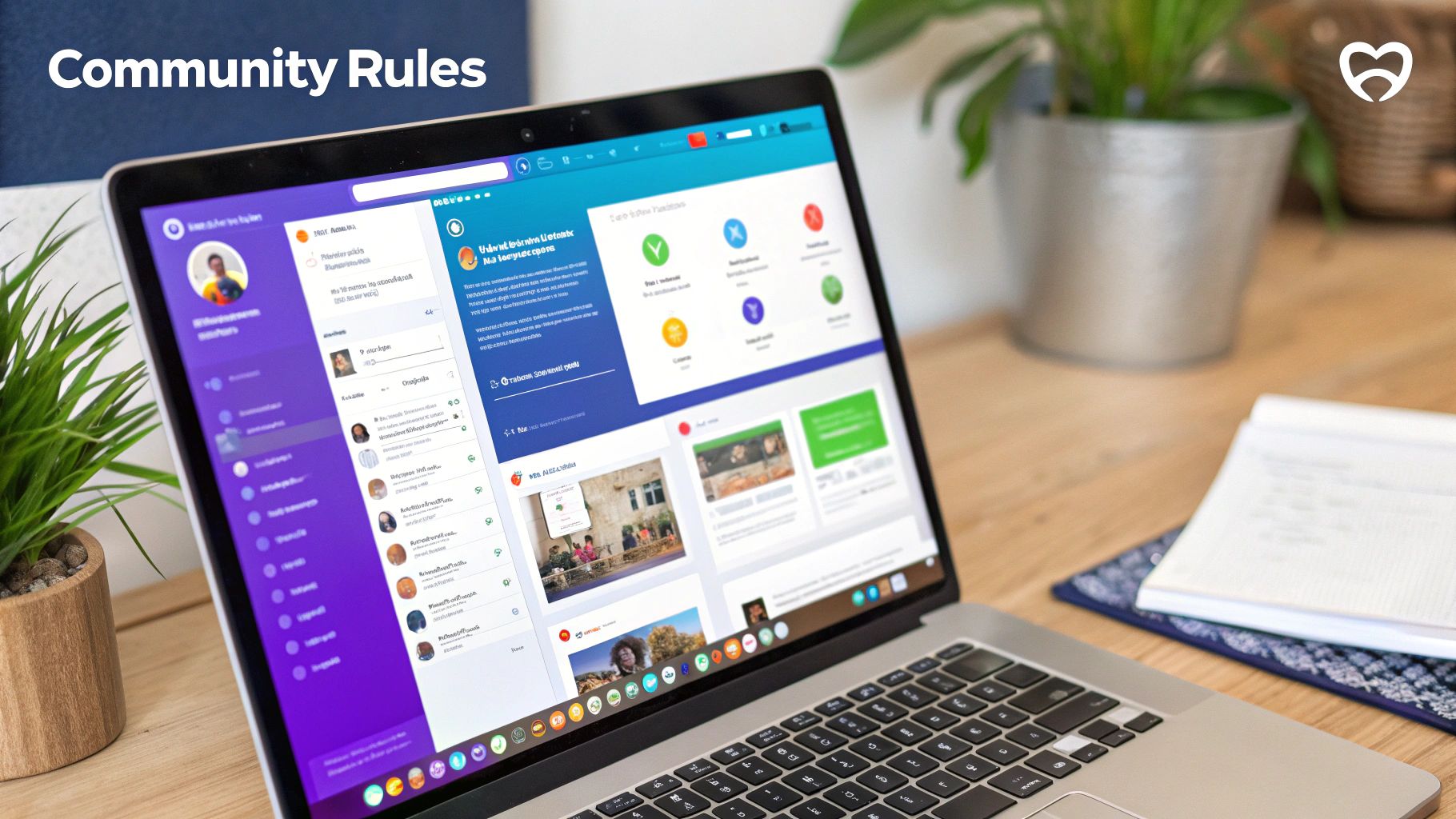The Evolution of Digital Connection: Where Communities Began
The internet has profoundly changed how we connect. Early online communities, like simple message boards and forums, were the foundation of today's dynamic online spaces. These basic platforms, despite technical limitations, provided a new way for people to connect based on shared interests. This marked a significant shift from geographically limited communities. Now, location didn't matter; anyone could find a place to belong online.
From Bulletin Boards to Social Networks: A Technological Leap
Technology played a key role in this change. Faster internet speeds and more advanced platforms dramatically increased connection possibilities. Threaded discussions, for example, enabled more organized conversations. Multimedia content like images and videos also enriched the online experience and boosted engagement within these growing communities. These advances not only improved existing platforms but also led to entirely new ones, designed to meet changing user needs.
The growth of internet access has been essential. Over the past few decades, the internet has become vital for communication, commerce, and information sharing. By 2025, almost two-thirds of the global population is expected to have internet access. Global internet users increased from just 2.8 million in 1990 to over 5 billion by 2023. This widespread adoption enabled online communities to connect people across the world. You can find more detailed statistics here: Explore this topic further. This increased accessibility has shaped online spaces and fueled the growth of online communities.
Learning From the Past: Building for the Future
Understanding this history is important for building online communities today. Past successes and failures provide valuable lessons. Early communities that focused on user experience, built a sense of belonging, and adapted to new technologies thrived. Those that didn't innovate or meet user needs often disappeared. This historical context is a valuable resource for building successful online communities. By learning from the past, we can create online spaces that connect people and empower them to share, learn, and grow together.
Finding Your Community's Digital Home: Platform Selection
Choosing the right platform is crucial for building a thriving online community. It's the foundation of your community's digital presence, and a poor choice can significantly impact growth and engagement. Selecting a platform isn't about ticking off the longest feature list; it's about finding the best fit for your community's unique needs and goals. This involves carefully considering your target audience, the community's purpose, and your budget.
To help you navigate this crucial decision, we've compiled a comprehensive comparison of popular community platforms. This guide goes beyond surface-level features, delving into the true costs, hidden limitations, and the types of communities that flourish on each platform.
Platform Evaluation: Beyond the Feature List
Savvy community builders don't just compare feature lists; they dig deeper. They consider factors like long-term sustainability, accessibility, and the platform's potential for growth. A platform might boast impressive features, but a clunky interface can deter users and hinder participation. Similarly, a platform with limited scalability can become a bottleneck as your community expands. A thorough evaluation ensures the platform supports, rather than hinders, your community's objectives.
Matching Platform Capabilities to Community Needs
The ideal platform aligns seamlessly with your community's purpose. A professional networking community has different needs than a hobbyist group. Consider the types of interactions you want to foster. Do you need robust Discourse forums, live chat functionality, or the ability to host virtual events? Choosing a platform that supports these specific requirements is essential.
To help illustrate the diverse landscape of community platforms and their unique strengths and weaknesses, we've created a detailed comparison table. This table provides a practical guide to understanding which platform might be the best fit for your community's specific needs.
Before we dive into the table, let's quickly recap what makes a successful online community platform:
- Clear Purpose: The platform should facilitate the core activities and goals of your community.
- Ease of Use: A user-friendly interface encourages participation and engagement.
- Scalability: The platform should be able to grow with your community.
- Cost-Effectiveness: Consider both upfront costs and potential hidden fees.
Platform Showdown: Where Should Your Community Live? An honest comparison of community platforms, revealing their true strengths, hidden costs, and which communities actually thrive on each
| Platform | Standout Features | True Cost Range | Ideal Community Type | Deal-Breaker Limitations |
|---|---|---|---|---|
| Discourse Forum Software | Threaded discussions, searchable archives, plugins | Free (open source) - $200+/month (hosting & support) | Large, discussion-focused communities | Can require technical expertise for setup and customization |
| Facebook Groups | Easy access, large potential audience, built-in features | Free | Casual communities, building initial awareness | Limited moderation control, algorithm dependence |
| Mighty Networks | Comprehensive features, customization options, mobile apps | $39+/month | Professional networks, branded communities, paid memberships | Higher cost, learning curve |
| Slack | Real-time communication, direct messaging, integrations | Free - $15+/user/month | Smaller teams, project-based communities, internal communication | Can become overwhelming for large communities, limited discoverability |
This table highlights the trade-offs inherent in each platform type. No single platform is perfect, making careful consideration essential.
Understanding Platform Usage Trends: Data Insights
Understanding current platform usage trends is key to informed decision-making. The data chart below visualizes user preferences for different community platform types, offering valuable insights into the evolving digital landscape.

The data reveals a notable trend: while 35% of users favor dedicated community platforms like Mighty Networks, a significant portion still prefers social media groups (25%) or forum software (20%). Messaging apps account for 10% of user preference, with another 10% opting for other specialized platforms. This data reinforces the importance of aligning your platform choice with your specific target audience and community goals. By strategically selecting your community's digital home, you lay the foundation for lasting growth and meaningful engagement.
Sparking Genuine Engagement: Beyond Basic Interaction
Building a thriving online community isn't just about providing a platform. It's about fostering genuine connections and encouraging meaningful contributions. Forget the outdated advice about "posting regularly." Real engagement requires a deeper understanding of your audience and a strategic approach to content and activities.
Content That Resonates: Understanding Your Audience
A successful community knows its content calendar should be driven by member interests, not just a rigid schedule. This means actively listening to your community and understanding their needs. Create content that directly addresses those needs. For example, a crafting community might offer online workshops demonstrating new techniques or host Q&A sessions with experienced artisans.
Choosing the right platform is also important. A forum-based community might find a resource like Discussion beneficial. This careful alignment of content with member interests ensures the community stays relevant and valuable.
Activities That Ignite Participation: Fostering Connection
Think beyond simple online discussions. Thriving communities design activities that encourage active participation and collaboration. Consider incorporating challenges, contests, or collaborative projects that tap into members' creativity and shared interests. Different formats, such as live Q&As, polls, or even virtual meetups can cater to diverse preferences and keep the community dynamic. For more ideas, check out this article on community engagement: How to master community engagement strategies for growth.
The growth of social media has significantly impacted the rise of online communities. By 2023, the number of social media users worldwide reached nearly 5 billion. You can find more detailed statistics here: Discover more insights about social media usage. This growth highlights the need for a more thoughtful approach to engagement, moving beyond basic interactions to build authentic connections.
Reward Systems: Recognizing Contributions
Recognizing and rewarding contributions is crucial for a strong community. Effective reward systems go beyond simple points or badges; they acknowledge helpful behavior, insightful contributions, and active participation. This could involve highlighting member achievements, showcasing user-generated content, or offering exclusive access to resources or events. This positive reinforcement cultivates a sense of belonging and encourages continued engagement.
Tailoring Engagement: A Personalized Approach
A one-size-fits-all approach to engagement simply doesn’t work. What resonates with a group of professional photographers might not work for a community of gamers. Understanding your members’ demographics, interests, and communication styles is essential. This involves analyzing community data, gathering member feedback, and constantly experimenting with new approaches. By adopting a data-driven and member-centric approach, you can create a thriving online community where members feel valued and empowered.
Building Spaces Where Everyone Truly Belongs
Creating inclusive online communities takes more than just good intentions. It requires a thoughtful strategy focused on fostering an environment where each member feels valued, respected, and empowered. By examining successful inclusive communities, we can learn how to build digital spaces where diverse voices thrive and contribute.
Accessibility For All: Designing For Inclusivity
Successful online communities prioritize accessibility from the ground up. This means considering the needs of members with disabilities by adhering to the WCAG (Web Content Accessibility Guidelines). Web Content Accessibility Guidelines (WCAG) provide a framework for making web content more accessible to people with disabilities. For instance, providing alternative text for images allows screen readers to describe visuals to users with visual impairments. Ensuring sufficient color contrast between text and background also improves readability for those with low vision. These seemingly small details significantly impact creating a welcoming environment for all.
Moderation That Protects Without Stifling: Finding The Balance
Effective moderation is crucial for a healthy community. It's about establishing a system that protects members from harassment and harmful content while still encouraging open expression. Striking this balance can be challenging. Overly strict moderation can feel like censorship, while lax moderation can lead to a toxic environment. The key is to develop clear community guidelines and enforce them consistently. Transparency in the moderation process builds trust and promotes fairness.
Fostering Respectful Dialogue: Setting The Tone
The language used within a community shapes its culture. Establishing norms that promote respectful dialogue is essential. This includes encouraging the use of inclusive language, discouraging personal attacks, and providing members with resources on effective communication. For example, using gender-neutral pronouns or avoiding slang can create a more inclusive atmosphere.
Identifying Exclusionary Patterns: Proactive Measures
Maintaining inclusivity requires ongoing attention. It means proactively identifying and addressing exclusionary patterns before they become ingrained in the community. This involves regular reviews of community interactions, actively seeking member feedback, and being adaptable in refining community guidelines as needed.

The widespread adoption of the internet has significantly contributed to the growth of online communities. In the U.S., approximately 96% of young adults used the internet by the mid-2010s. Furthermore, internet usage among seniors rose from 14% in 2000 to 58% by 2015. This illustrates the wide appeal of online spaces. For more statistics on internet usage, you can Explore this topic further. This growth highlights the potential of online communities to connect diverse groups. If you're interested in creating your own online space, check out this resource on How to create a membership site.
To encourage engagement within your community, consider exploring some of the social media ideas for schools presented in this helpful resource. Adapting these strategies can facilitate interaction and strengthen your community. By focusing on accessibility, moderation, and respectful dialogue, we can build thriving online communities where everyone belongs. This leads to a stronger, more vibrant, and ultimately, more successful online experience for all.
Community Management That Actually Works

Behind every thriving online community is a dedicated team of community managers. These individuals cultivate positive online experiences, shaping the environment and encouraging meaningful interactions. This involves tackling the daily challenges of maintaining healthy digital spaces and implementing practical solutions.
Establishing Effective Community Guidelines
Building a successful online community starts with clear guidelines. These guidelines act as a code of conduct, setting expectations for member interactions and platform use. Flourishing communities don’t just create rules; they actively promote them and ensure they're easy to understand. This transparency helps prevent misunderstandings and fosters a respectful and productive environment.
Moderation Strategies That Scale
As communities grow, effective moderation becomes crucial. This means developing scalable strategies to maintain a positive atmosphere without overburdening community managers. One approach is a tiered moderation system, empowering trusted members to help flag inappropriate content. This shared responsibility eases the workload on managers and builds a sense of community ownership. Learn more about growth strategies in our article about creating an online community with proven growth tactics.
Conflict Resolution: Maintaining Harmony
Disagreements are inevitable in any community. How these conflicts are handled significantly impacts the overall health of the online space. Effective community managers develop strategies for mediating disputes and resolving issues constructively. This could involve private discussions, facilitating open dialogue, or implementing temporary restrictions. The goal is to address the conflict while maintaining relationships and promoting respectful communication.
Fostering Self-Sustaining Cultures
The best online communities become self-sustaining. Members actively shape the culture and contribute to its maintenance. The community manager acts as a guide, nurturing growth and fostering shared responsibility. This creates a stronger sense of ownership and a more engaging experience for everyone.
Navigating Sensitive Situations
Occasionally, sensitive issues arise within online communities. These might involve discussions on controversial topics, harassment reports, or even the loss of a community member. Community managers must handle these situations with empathy and tact. This might include offering resources, facilitating open discussions, or adjusting community guidelines. The focus should remain on community well-being and member support.
To further illustrate effective moderation techniques, the following table presents a comparison of different approaches:
Moderation Approaches That Build (Not Break) Communities Real-world analysis of different moderation strategies, revealing which actually strengthen communities versus those that silently drive members away
| Moderation Approach | Implementation Method | Team Requirements | Member Experience Impact | Community Types Where It Thrives |
|---|---|---|---|---|
| Reactive Moderation | Responding to flagged content | Small team | Can feel inconsistent, potential for negative experiences | Smaller, less active communities |
| Proactive Moderation | Regularly monitoring community activity | Larger team | Creates a safer environment, can be perceived as restrictive | Larger, more active communities |
| Community-Based Moderation | Empowering trusted members to moderate | Distributed team, strong community culture | Fosters a sense of ownership, can be challenging to manage | Communities with strong established norms |
| Automated Moderation | Using tools to automatically filter content | Technical expertise | Efficient, can lead to false positives | Large communities with clear content guidelines |
As shown in the table, each approach presents unique benefits and challenges. Selecting the right strategy depends heavily on the specific community’s size, culture, and goals.
By strategically applying these methods, community managers cultivate online spaces that are not only engaging and informative, but also supportive and inclusive. This creates an environment where members feel valued, respected, and empowered to contribute meaningfully.
Measuring What Matters: Community Health Metrics
Creating a thriving online community takes more than just building a platform and hoping for the best. It requires continual evaluation and strategic adjustments based on key performance indicators (KPIs). Simply tracking basic engagement metrics like page views or likes can be misleading. These surface-level numbers don't tell the whole story. True community health delves much deeper than initial interactions. This section explores the essential metrics that predict long-term community success.
Beyond Vanity Metrics: Identifying True Indicators of Success
Many community builders fall into the trap of focusing on vanity metrics. These are numbers that look impressive but don't reflect the true health of a community. For example, a large number of registered users is meaningless if they remain inactive. Similarly, a high volume of posts doesn't necessarily indicate meaningful engagement. The crucial question is: are these interactions building real connections and furthering the community's purpose?
Instead of vanity metrics, successful community builders focus on indicators that reveal the quality of interactions.
-
Active Member Ratio: This is the percentage of registered users who actively participate. A higher ratio suggests a more engaged community.
-
Member Retention Rate: This metric tracks the percentage of members who remain active over time. It reflects the community's ability to retain its members and foster ongoing participation.
-
Contribution Depth: This measures not just the number of contributions, but their quality. This might include the length and depth of posts, or the frequency of helpful responses, demonstrating genuine engagement.
-
Mutual Support: Tracking how often members help each other indicates a strong sense of community and a willingness to collaborate.
Establishing Meaningful KPIs: Aligning with Community Goals
The most effective KPIs depend on your community's specific goals. A community focused on knowledge sharing will have different KPIs than one focused on customer support. For example, a support community might prioritize resolution time – how quickly members get answers.
A learning community, however, might focus on course completion rates or knowledge assessment scores. Aligning your KPIs with your community's purpose ensures you're measuring what truly matters for your specific objectives.
Implementing Measurement Systems: Practical Approaches
Measuring community health doesn't require advanced data analysis skills. Many platforms offer built-in analytics dashboards that provide valuable insights. Google Analytics is one example of a powerful tool for tracking various metrics. Additionally, simple spreadsheets can be effective tools for tracking and analyzing your chosen KPIs. Start with a few key metrics and gradually refine your system as your community grows.
Reporting Frameworks: Demonstrating Value to Stakeholders
Clearly communicating your community's progress is crucial for securing continued support. Develop reporting frameworks that showcase the impact of your community-building efforts. This might involve presenting data on member satisfaction, cost savings from reduced support tickets, or the generation of new leads through community interactions. By demonstrating the tangible value of your community, you can justify ongoing investment.
Data-Driven Decisions: Strengthening Community Bonds
Successful community builders use data not only to track progress, but to make informed decisions. By analyzing community metrics, you can identify emerging opportunities, address problems proactively, and adapt your strategies to better meet member needs. This data-driven approach helps you build stronger community bonds and ensure long-term sustainability.
Ready to transform your Shopify store into a thriving hub of connection and learning? Discover how Tevello can help you build a powerful online community integrated seamlessly with your eCommerce platform.




